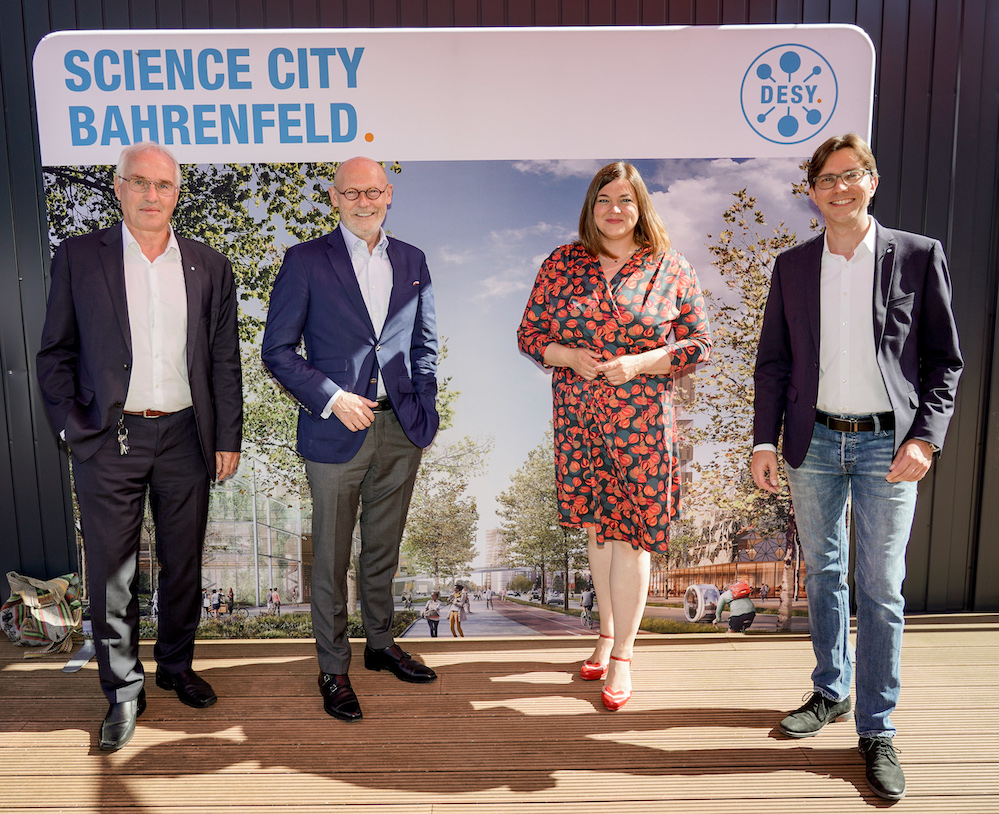DESY: Driver for innovation and the Science City Hamburg-Bahrenfeld
Katharina Fegebank, Hamburg’s Senator for Science and Michael Westhagemann, Senator for Economics and Innovation visited DESY today to learn about DESY's innovation activities as part of their summer tour for innovation. The focus was on how the cooperation between industry and science can lead to innovation. Furthermore the compact accelerator technology, which has a high potential for various innovations in medicine and materials research has been discussed.
How is Science City Hamburg Bahrenfeld coming along? This district of Hamburg devoted entirely to science and innovation, which is being built around the DESY campus, will be a livable urban space linking research and teaching with business and housing. "Many companies are already working together with research institutions and universities in Hamburg, our innovation location. As a knowledge metropolis, we have a lot of expertise and know-how in one place. The international networking, interdisciplinary approaches and unique research facilities at DESY ensure that numerous groundbreaking developments in basic research originate here in Hamburg - as recently in mRNA vaccine development. In this case, DESY is advancing the future field of materials science, offering concrete areas of application from medical technology to everyday use," says Katharina Fegebank. She adds, "These kinds of innovative approaches excite me. And looking ahead also makes me hopeful: the Bahrenfeld Research Campus continues to grow and, as an integral part of Science City Hamburg-Bahrenfeld, will set standards for combining urban development, science and living in the future."
A cooperation in the 3D printing field that DESY has entered into with DMG Digital Enterprises is a stellar example: Together, the partners are testing and optimizing materials for 3D printing for use in extreme environments such as ultra-high vacuum. For example, the resin Moiin: This is used in medical technology, but can just as easily be used in jewelry design. "The collaboration between DESY and DMG exemplifies what close networking between science and industry can look like and the progress it can lead to when placed on a sound footing, such as that offered by Science City Hamburg-Bahrenfeld," says Michael Westhagemann, Hamburg's Senator for Economics and Innovation. "We welcome such and similar initiatives and will actively promote them wherever possible in the context of the Science City."
DESY is also committed to being a driver and starting point for further activities in the field of transfer and innovation: "Opening up to industry, cooperations with application-oriented research, strong regional networking for the further expansion of the innovation ecosystem are measures with which DESY intends to strengthen the innovative power of the metropolitan region," explains Helmut Dosch, Chairman of the DESY Directorate.
Compact accelerators as future technology
The second focus topic of the senators' innovation tour at DESY was the development of compact accelerators. Several research groups at DESY are working on making the complex technology of laser-plasma acceleration of electrons, which enables high energies over very small distances, more flexible to use. For example, when it comes to studying materials and active substances at atomic resolution. The researchers want to shrink football-field-long facilities to about the size of a moving van and make their operation easier and more automated. The compact accelerators are to be developed specifically for various applications in science and industry and, in the long term, will complement large-scale research facilities such as DESY's synchrotron radiation source PETRA III.
In recent months, DESY researchers have achieved many milestones on the way to the concrete application of this technology. For example, they recently succeeded in operating a facility around the clock for the first time, and they were also able to optimize the plasma wave of an accelerator thanks to artificial intelligence, thereby increasing acceleration efficiency. "By transferring this technology so that companies and universities can also do their research on site, we accelerate innovation cycles," says Dr. Arik Willner, chief technology officer at DESY. "This way, the technologies we develop can benefit society even more."
In addition to DESY, the third stop on the innovation tour, the two Hamburg senators have already visited Hamburg Technical University and semiconductor manufacturer NXP. On September 16, the summer tour will conclude with a visit to the Bergedorf Energy Campus / Reallabor.
Science City Hamburg-Bahrenfeld (SCHB)
Science City Hamburg-Bahrenfeld (SCHB) is currently being built around the DESY campus. In the future, the research location will link living, teaching, business and innovation. Here, science and industry are to be networked, innovation potential bundled and cooperation partners, such as small and medium-sized enterprises, worked together.
Hamburg is setting new accents as a city of knowledge: Science City 2040 is being created in Bahrenfeld. The DESY research and technology center, parts of the University of Hamburg and other top scientific institutes are already ensuring international appeal at the Bahrenfeld site. Further scientific areas of the University of Hamburg, the Altona Innovation Park and housing projects will bring additional dynamism to the district. The Altona Volkspark, Hamburg's largest park, is located in the immediate vicinity of Science City. Both will benefit from each other.
Further info:
https://sciencecity.hamburg/
published
- 2021/09/08
Press Contact
- innovation@desy.de


